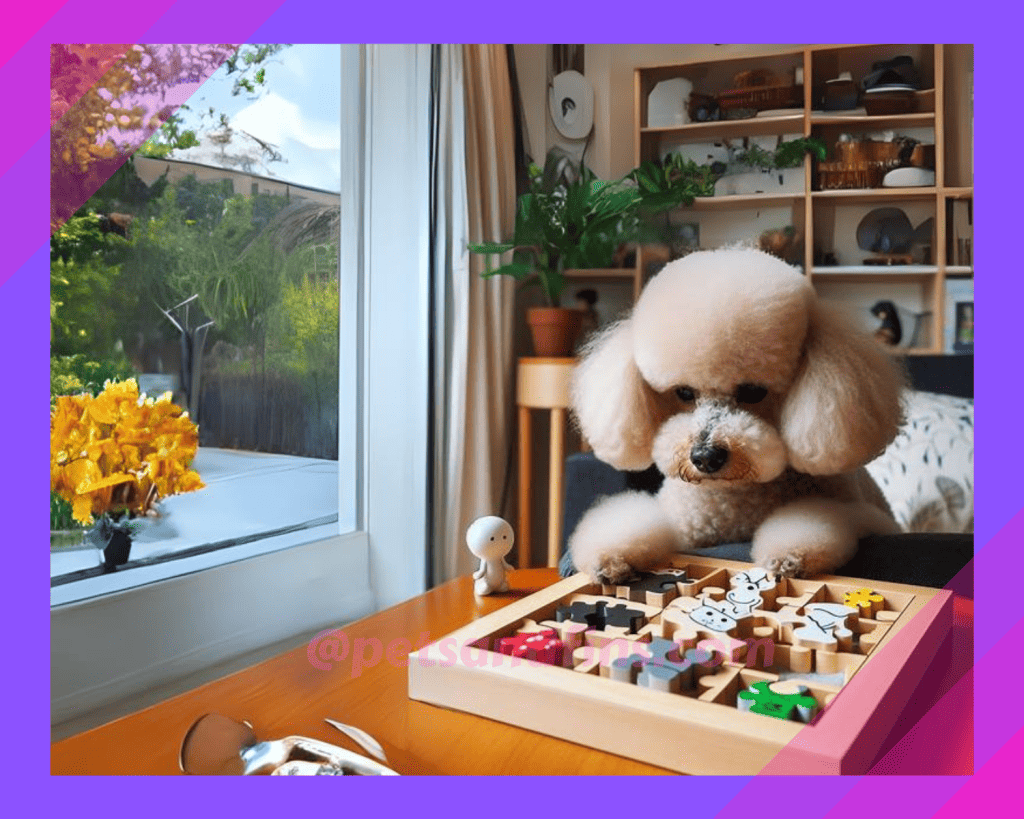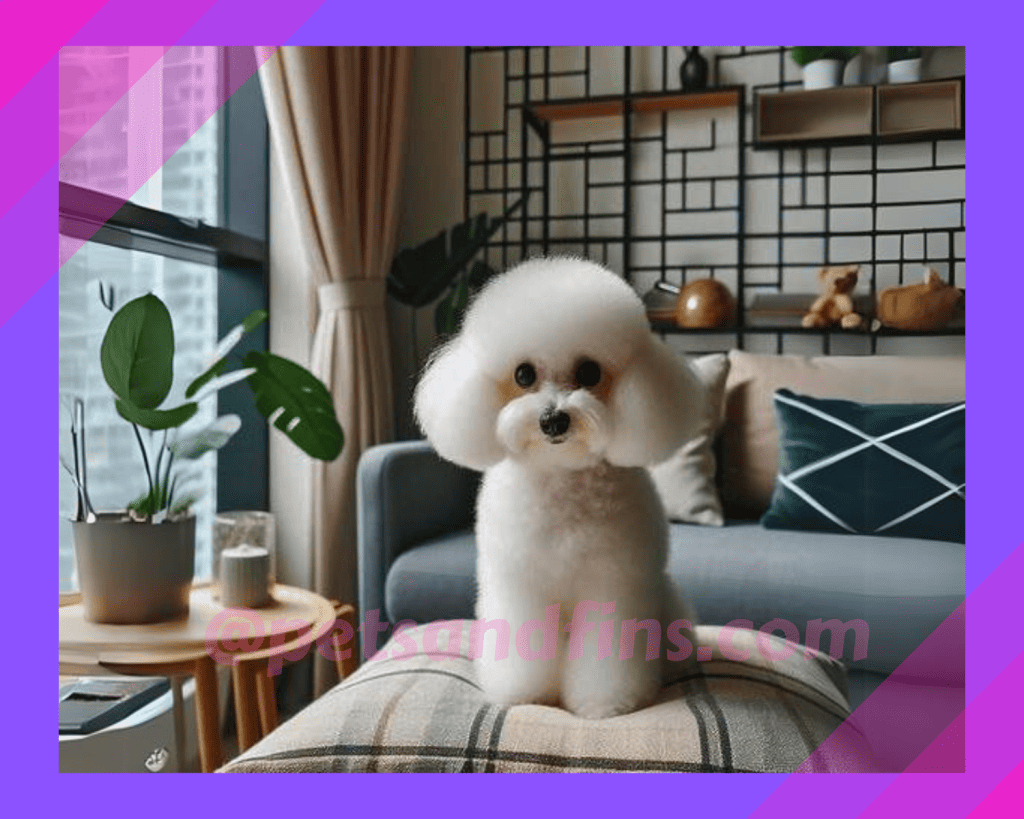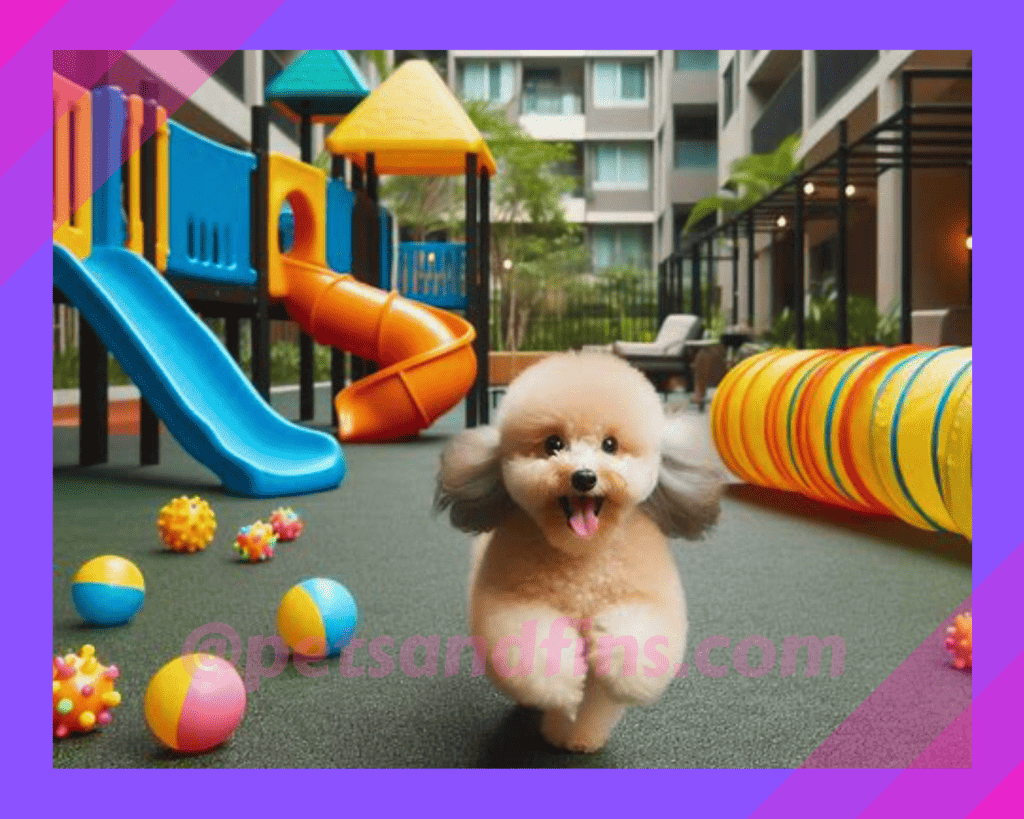Hey there, fellow apartment dwellers and poodle enthusiasts! Discover crucial aspects of having poodles in apartments. Expert advice on creating a harmonious environment for your furry friend. Let’s delve even deeper into the world of furry companions and apartment living. Having a cozy space doesn’t mean we can’t enjoy the joyous company of a poodle.
There’s a fantastic array of poodle breeds that fit snugly into our apartment lifestyles. Here’s an extensive exploration of the top 7 apartment-friendly poodle breeds and essential considerations for finding the perfect match. Apart from this, we will also look into various considerations to be taken into account.
1. Toy and Miniature Poodles in Apartments

Toy and Miniature Poodles are like the original apartment buddies! Their small stature and adaptability make them an ideal choice for apartment living.
Despite their compact size, they are brimming with energy and intelligence, making them well-suited for indoor activities. Keep an eye on barking tendencies, as some individuals might be more vocal than others.
Toy and miniature Poodles are ideal companions for apartment living due to their size, temperament, and adaptable nature. Their compact stature makes them well-suited for smaller living spaces, requiring less room to move around compared to larger breeds.
Their manageable size translates to easier accommodation within limited apartment settings, allowing them to thrive in cozy environments without feeling cramped.
Additionally, these smaller Poodle variants typically have lower exercise requirements compared to standard-sized Poodles, making it more feasible to meet their activity needs indoors or in smaller outdoor spaces.
2. Crossbreeds: Clever Combinations
Cross-breed poodles, with their diverse genetic makeup, often possess a blend of characteristics that make them exceptionally well-suited for apartment living. Their adaptable nature, inherited from a mix of breeds, often results in a temperament that combines the intelligence and trainability of poodles with the traits conducive to compact living spaces.
These dogs frequently exhibit a more moderate energy level compared to some purebred counterparts, making them better suited to the limited space of an apartment. Additionally, cross-breed poodles might inherit a variety of coat types, potentially resulting in less shedding or a coat that requires less maintenance, a boon for indoor living.
Their adaptability and versatility, influenced by a blend of genetic traits, often make cross-breed poodles an excellent choice for apartment dwellers seeking a companion that comfortably thrives in a smaller living environment while still embodying the endearing qualities of the poodle lineage.
Crossbreeds like Cockapoo, Yorkipoo, Schnoodle, BiDoodle, and Shipoo bring the best of poodles and other breeds together.
Their versatility and moderate size often make them excellent choices for apartment life. These unique blends inherit traits that complement apartment living, such as reduced shedding and an adaptable nature.

3. Understanding Individual Traits

When picking an apartment-friendly poodle, consider their distinct characteristics. Some breeds shed less than others, which is beneficial for keeping your living space clean.
Energy levels differ among breeds, so it’s essential to match a dog’s energy to your lifestyle. Highly trainable breeds adapt well to apartment life and learn to behave indoors.
Delving into their individual traits allows for a deeper appreciation of their distinct personalities, shedding light on their potential temperament, energy levels, grooming needs, and health considerations.
Each crossbred Poodle is a fusion of diverse traits, which, when comprehended, aids in tailoring care, training, and interactions to suit their specific needs.
Recognizing and understanding these individual traits not only enriches the bond between owner and pet but also helps in providing tailored care, support, and an environment where these endearing crossbreeds can flourish and thrive to their fullest potential.
4. Size Matters but Isn’t Everything
Size is a crucial factor in apartment living, but it’s not the only one. While smaller poodles generally fit into apartments seamlessly, some larger ones can adapt too. Miniature poodles strike a balance between size and adaptability. Assess the available space in your apartment to ensure your poodle has room to move around comfortably.
When it comes to poodles thriving in an apartment, size isn’t the sole determining factor for their happiness or suitability. While smaller poodles, like toy or miniature varieties, might seem inherently more apartment-friendly due to their size, it’s the breed’s temperament, exercise needs, and adaptability that truly matter.
Standard poodles, though larger in size, often exhibit a calm and adaptable demeanor, making them equally well-suited for apartment living. These dogs possess a remarkable adaptability and are known for their intelligence, making them quick to understand and comply with indoor living requirements.
Moreover, their energy levels can be managed through regular exercise and mental stimulation, irrespective of their size.
What truly counts in an apartment setting is a poodle’s disposition, their need for mental engagement, and the owner’s commitment to providing adequate exercise and mental stimulation rather than their physical size. With the right care, attention, and a fulfilling environment, poodles of various sizes can thrive and lead content lives within apartment spaces.

5. Health and Age: Considerations for Comfort

A poodle’s age and health play significant roles in how they adapt to apartment life. Younger dogs may have more energy and might require more active engagement.
On the other hand, older poodles could be calmer and content with moderate exercise. Assessing their health ensures a comfortable living environment for both you and your furry friend.
Their longevity, with an average lifespan ranging between 10 to 18 years, allows them to comfortably adjust to apartment life throughout their years, provided they receive adequate mental stimulation, moderate exercise, and the affectionate companionship they thrive on.
6. Designated Exercise Areas
Living in an apartment doesn’t mean your poodle can’t enjoy exercise. Look for nearby parks or allocate a designated area indoors for playtime and activities. Regular exercise not only keeps them physically fit but also contributes to their mental well-being.
Indoor Play Sessions: Engage in interactive indoor games like fetch, tug-of-war, or hide-and-seek. Utilize soft toys or balls to play in a confined space, providing mental and physical stimulation.
Training Exercises: Incorporate mental workouts into their routine through obedience training sessions. Teach new tricks, practice commands, or work on agility exercises using compact, apartment-friendly equipment like cones or hurdles.
Stair Climbing: If your apartment has stairs, utilize them for a mini cardio session. Safely guide your poodle up and down the stairs to provide a quick burst of exercise that targets their muscles and helps burn energy.
Treadmill or Indoor Running: Consider using a dog-friendly treadmill designed for pets. Start slow and gradually increase the pace to give your poodle a controlled indoor run when outdoor walks aren’t feasible.
Interactive Toys and Puzzles: Invest in puzzle toys or treat-dispensing gadgets that mentally challenge your poodle. These toys encourage problem-solving and keep them engaged while providing a form of mental exercise.
Scheduled Outdoor Adventures: Even though you’re in an apartment, regular outdoor adventures are vital. Take daily walks, visit nearby dog parks, or explore dog-friendly trails or areas to offer your poodle a change of scenery and ample space for a more exhaustive exercise routine.
Mixing and matching these activities while ensuring consistency in their exercise routine will help keep your poodle physically active and mentally stimulated despite the confined space of apartment living.

7. Apartment Regulations: A Critical Check

Before bringing home a poodle, ensure your apartment’s pet policies align with your furry friend’s needs. Some places have specific restrictions concerning breeds, sizes, or the number of pets allowed. It’s crucial to double-check these rules to avoid any complications later on. Here are some aspects to consider.
Size Restrictions: Some apartment complexes or landlords may have size limitations for dogs. Standard poodles, especially, being larger in size, might fall under restrictions imposed by certain apartments that only allow smaller breeds.
Breed Restrictions: Unfortunately, some apartments enforce breed-specific regulations, and while poodles are typically well-received due to their hypoallergenic coat, there might still be places that have restrictions against certain breeds, including poodles.
Noise Regulations: Poodles, if not properly trained or stimulated, can bark when bored or anxious. Some apartments might have strict noise regulations, and excessive barking might cause concerns among neighbors or violate the apartment’s rules.
Exercise and Space: Poodles, despite their adaptability to smaller spaces, still require regular exercise. Some apartments might have limited outdoor areas or lack nearby parks for adequate exercise, which could pose a challenge in meeting a poodle’s activity needs.
Deposit or Additional Fees: Certain apartments might charge additional fees or require a higher deposit for pet owners. This financial aspect can be a restriction for some poodle owners considering apartment living.
Leash and Common Area Policies: Apartments often have strict leash policies and rules regarding the use of common areas. This might restrict the freedom of letting a poodle roam freely in shared spaces within the apartment complex.
Grooming Space: Poodles, known for their luxurious coats, often require regular grooming. Living in an apartment might pose challenges in finding adequate space to groom them properly, especially for larger poodles that need more grooming space.
Allergies and Sensitivities: While poodles are hypoallergenic, some individuals might still have allergies or sensitivities to pet dander. Some apartments might have strict policies due to potential allergies among residents, impacting the ability to keep a poodle in the apartment.
Visiting Restrictions: Certain apartments might have restrictions on guests bringing pets. This could limit the ability to have friends or family visit with their own dogs, impacting social interactions for poodle owners.
Elevator or Stair Use: For high-rise apartments, using elevators or navigating stairs with a poodle, especially if it’s a standard size, might pose challenges, especially if the pet is uncomfortable with elevators or if the building has strict rules regarding pets in shared spaces like elevators.
Adhering to these considerations helps ensure a harmonious living environment for both poodle owners and their beloved pets within an apartment setting.

5 Toy and Miniature Poodles: Perfect for Apartments

When considering a poodle for apartment living, it’s vital to scrutinize various facets. Understanding breed traits, energy levels, and your living space dynamics are crucial elements. By taking a holistic approach, you can choose the perfect poodle that seamlessly integrates into your apartment lifestyle!
Cockapoo: A mix of Cocker Spaniel and Poodle, are generally well-suited for apartment living. They are adaptable, small to medium-sized dogs that thrive on human companionship. Their moderate exercise needs can be met with regular walks and playtime indoors, making them a good fit for apartment dwellers.
Yorkipoo: A cross between Yorkshire Terriers and Poodles, are small, energetic, and well-suited for apartment life. They’re affectionate, and intelligent, and adapt well to smaller living spaces. Daily walks and interactive play sessions indoors suffice for their exercise needs.
Schnoodle: A mix of Schnauzers and Poodles, they are adaptable, intelligent, and often well-suited for apartment living. They tend to inherit the Poodle’s intelligence and Schnauzer’s alertness. They enjoy moderate exercise and can adapt to indoor living, provided they receive mental stimulation through play and training.
BiDoodle: A mix of two types of doodles (like Bernedoodles and Goldendoodles), can vary in size and temperament. However, generally, they are friendly, intelligent, and adaptable, making them suitable for apartment life, especially if they inherit a smaller size and lower energy levels from one parent.
Shippo: A cross between Shih Tzus and Poodles, are affectionate, loyal, and adaptable. They are typically small-sized dogs that do well in apartments due to their moderate exercise needs. They enjoy indoor play but also benefit from short walks or outdoor activities.
Conclusion
In conclusion, poodles, with their adaptable nature, moderate exercise requirements, and varying sizes across different breeds like the Standard, Miniature, and Toy Poodles, can make excellent companions for apartment living. Their intelligence, affectionate demeanor, and ability to adjust to indoor spaces make them well-suited for apartment life. However, regardless of the specific poodle breed, it’s vital to consider their individual temperament, exercise needs, and the time and dedication required for their care and mental stimulation. With proper attention, exercise, and love, a poodle can thrive happily in an apartment environment, bringing joy and companionship to their owners.
References:
Best Dogs for Apartments – American Kennel Club (akc.org)


